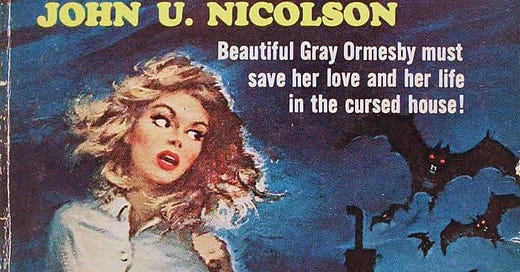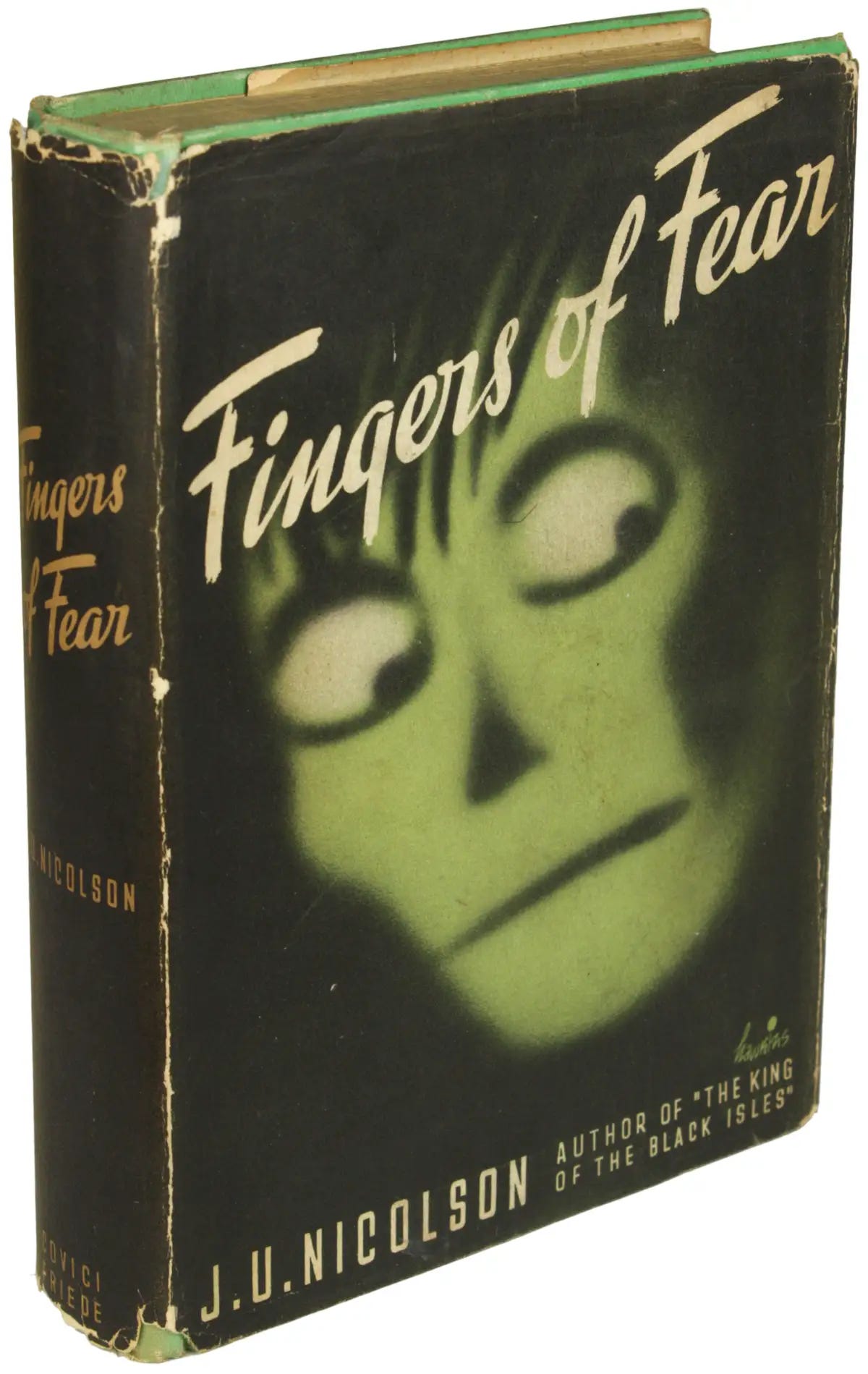Dearest ghouls. we are once again venturing into the dark domain of Karl Edward Wagner’s 39 List. This time we are discussing a slim volume listed as number ten among the Thirteen Best Supernatural Horror Novels. The book in question, J.U. Nicolson’s Fingers of Fear, was published in the Depression year of 1937. At a trim 213 pages, Fingers of Fear is an American gothic potboiler that combines the outlandish and outré with the absolutely disgusting. As a result, the book is today as obscure as its author.
Not too much is known about Mr. Nicolson. We do know that he was born in Alma, Kansas in 1885. And we know that he died of coronary thrombosis in Mason, New Hampshire in 1944. Beyond that, Mr. Nicolson’s biography is sparse. During the 1920s, he published poetry, with volumes entitled King of the Black Isles (1924), The Sainted Courtezan (1924), and The Drums of Yle (1925). Nicolson apparently spoke French, as he also made coin translating the works of François Villon (and Geoffrey Chaucer to boot). Rumors suggest that he was a scholar of medieval literature. Fingers of Fear was Nicolson’s lone novel, and by all accounts it received praise upon publication. However, Nicolson must have put down his pen, for, at the time of his death, he was working as a manager at a storage warehouse [1].
Set during the summer of 1933, Fingers of Fear opens with the financial plight of New York Bonhomme Selden Seaforth. Out of luck, out of money, and out of an engagement, Seaforth needs something (anything) to get him on his feet again. Enter his old college chum Ormond Ormes. The wealthy Ormes offers Seaforth a job as a private librarian at his family home in the Berkshires of Massachusetts. On top of that, Ormes tells Seaforth that $100,000 can be his if he can write a history of the Elizabethan influence on American Colonial literature within the span of a year. Seaforth agrees to help his old friend secure the praise of Harvard and Dartmouth, and within days he takes a motor northwards to rural New England.
Even before leaving New York, Seaforth is informed that Ormesby, the sprawling mansion, has a ghost. Then, when Seaforth enters the strange domicile and is enchanted by the beautiful Gray Ormes (Ormond’s sister), he also learns that the house has a wandering madwoman. Seaforth sees his first ghost — a woman in white in the library — within the first twenty-four hours. Then, after his first night sleeping in the house, Seaforth wakes up with bite marks on his neck. Is there a vampire in Ormesby? Maybe, but the house for sure has a tragic history. Gray informs Seaforth that her father murdered her mother, and that both bodies are stashed somewhere within the house. Within these same secretive walls, Gray believes that there is a fortune. As if all of this weren’t enough, Seaforth is frightened out of his socks one night by a vision of a nude and bloody Gray howling up at the moon. So…a vampire and a werewolf?
Fingers of Fear is a dizzying yarn, with hidden passages, an evil twin sister, and murder galore. After one servant’s throat is slashed, bodies begin stacking up, with one very important corpse found in the garage. Romantic intrigue arrives too in the form of Seaforth’s former fiancée, who shows up at Ormesby on the arm of a now cold and cruel Ormond. Oh, and one cannot forget about themes of sexual violence, patricide, and incest. Fingers of Fear truly adds the “American” in American gothic, for this otherwise simple haunted house narrative takes everything to nightmarish extremes.
The biggest problem with the book is that it is too cluttered and convoluted. Too much happens, and too many things are suggested, and as a result, readers get vertigo by page one hundred. Another issue is the large cast of characters in Ormesby. It can be very hard keeping all the women straight, from Ormond’s wife to his sister and aunt. Finally, and this was something noted by our friend at The Weird and the Wonderful, so much of this book concerns the moving of bodies from one place to another to either avoid detection or further some kooky conspiracy. Basically, if you want to read Fingers of Fear, be ready to outline or build your own blueprint.
It is a shame that Nicolson never returned to horror. His writing here is deliciously atmospheric, and Fingers of Fear excels at making a reader feel dread on every page. The book is also enjoyable as a time piece, for, like a lot of other weird and horrific tales penned during the Interwar Years, Fingers of Fear has one foot in the late Victorian Age and the other in the electric epoch. Antiquarian horror mixes with Freudian psychology in Nicholson’s lone offering, and ultimately the novel’s supernatural elements are confirmed, but not confirmed totally. There is still doubt like a lingering trace of madness in the mind.
Fingers of Fear could have been a great book, but it is reduced to being just good due to its busy plot. The editorial blue pen should have been used more viciously back in 1937, but alas, the final product is a solid B.
Overall rating: 3 out 5.
FINAL NOTE: Everyone who enjoys reading these reviews or the other content that we provide here at the Bizarchives, please like and subscribe. We are not going to lie to you — the Bizarchives is currently hurting. We are still working on new editions and novellas, but we need your support to reach the finish line. Please consider becoming a paid subscriber today! THANK YOU, BIZARKINGS.
[1]: All biographical information was taken from Valancourt Books’ 2015 edition of Fingers of Fear.




